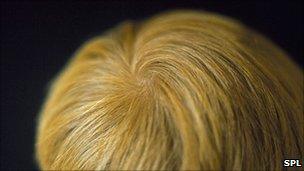Hair colour predicted from genes
- Published

Red hair can be estimated with around 90% accuracy, the study says
Scientists say they have developed a way to predict a person's probable hair colour using markers in their DNA.
The study paves the way for a forensic test that could estimate the hair colour of a suspect from DNA left at a crime scene.
The information could then be used to refine the description of an unknown but wanted person.
A Dutch-Polish team of researchers have published details in the journal Human Genetics, external.
The researchers found that it was possible to determine with an accuracy of more than 90% whether a person had red hair, with a similar accuracy for people with black hair
They could estimate with an accuracy of more than 80% whether a person's hair colour was blonde or brown.
Predictive power
This new genetic approach is also able to differentiate between some hair colours that are similar, for example, between red and reddish blonde, or between blonde and dark blonde hair.
The DNA can be taken from blood, sperm, saliva or other samples that would be relevant in forensic case work, say the researchers.
Lead scientist Manfred Kayser, from Erasmus University Medical Center in Rotterdam, said: "That we are now making it possible to predict different hair colours from DNA represents a major breakthrough because, so far, only red hair colour, which is rare, could be estimated from DNA.
The researchers studied DNA and hair colour information from hundreds of Europeans. They investigated genes previously known to influence the differences in hair colour.
"We identified 13 'DNA markers' from 11 genes that are informative to predict a person's hair colour," said Professor Kayser, chair of the Department of Forensic Molecular Biology at Erasmus.
Emerging field
Predicting human "phenotypes" - a person's outward traits such as hair colour or eye colour - from DNA information is a newly emerging field in forensics.

Scientists have developed a way for estimating age using T cells
Genetic profiling compares DNA at a crime scene with that of a known suspect or with other profiles in a database in search of a match. But researchers say that when this approach draws a blank, clues to the appearance of a suspect could provide valuable leads in an investigation.
But only a few phenotypic traits can currently be identified from DNA information with enough accuracy to have practical applications.
"This research lays the scientific basis for the development of a DNA test for hair colour prediction," said Professor Ate Kloosterman of the Netherlands Forensic Institute (NFI).
"A validated DNA test system for hair colour shall become available for forensic research in the not too distant future."
He added: "This new development results in an important expansion of the future DNA tool-kit used by forensic investigators to track down unknown offenders."
But according to Mark Shriver, a biological anthropologist at Penn State University, US, the fact that the research was carried out on a European sample group means that these genes may not be as useful for predicting hair colour in, for example, African or Asian populations.
Professor Kayser's team at Erasmus University has already developed a test for eye colour based on DNA markers. In September they published details of a technique to estimate the age of a suspect, external from blood left at a crime scene.
The method exploits a characteristic of immune cells carried in the blood known as T cells. The approach enables scientists to estimate a person's age, give or take nine years either side.
- Published23 November 2010
- Published5 August 2010